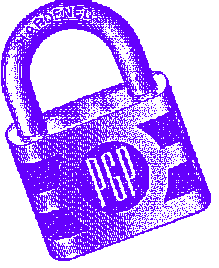
MIT distribution site for PGP
(Pretty Good Privacy)
PGP or Pretty Good (TM) Privacy is a high-security cryptographic
software application that allows people to exchange messages with both
privacy and authentication.
Privacy means that only those intended to receive a message
can read it. By providing the ability to encrypt messages, PGP
provides protection against anyone eavesdropping on the network. Even
if a packet is intercepted, it will be unreadable to the snooper.
Authentication ensures that a message appearing to be from
a particular person can have originated from that person only, and
that the message has not been altered. In addition to its support for
messages, PGP also enables you to encrypt files stored on your
computer.
MIT distributes PGP free for non-commercial use. This distribution is
done in cooperation with Philip Zimmermann, the author of PGP, and
with RSA Data Security, Inc., which licenses patents to the public-key
encryption technology on which PGP relies.
How to obtain PGP from MIT
PGP is distributed by MIT only to US citizens within the United
States.
MIT distributes PGP in both in source and in and executable only
versions. PGP is available for most DOS, Macintosh, and Unix
platforms. The current versions of PGP being distributed by MIT are:
- For DOS and Unix platforms, MIT has been distributing PGP
version 2.6.2 since October 24, 1994.
- For the Apple Macintosh, MIT has been distributing MacPGP version
2.6 since June, 1994.
To obtain the current version of PGP from MIT via the World-Wide Web,
click here.
If you do not have WWW access, you can use anonymous FTP to
net-dist.mit.edu. Look in the directory pub/PGP and follow the
directions in the README file.
PGP is available from MIT by WWW or FTP access only. If you do not
have such access you will need to obtain PGP from another source.
Integrating PGP with mail programs
PGP is much more convenient to use in conjunction with an interface
that integrates it into programs for reading and sending mail.
Several such interfaces are available for popular mail programs. The
ones distributed by MIT are:
Here are some other PGP/mail interfaces (not distributed by MIT):
-
There are several PGP shells for Windows
users. You can find out more about them
here.
-
For users of MH mail on Unix, exmh is an X-Windows
user interface to MH mail, which provides PGP support. You can find
information about exmh
here.
- Offline
AutoPGP is a PGP-based e-mail encryption package for use with PGP
and offline mail readers on DOS machines.
-
For Macintosh users, there is a suite of MacPGP tools
being developed by the Macintosh
Cryptography Interface Project. These generally require a new
version of MacPGP (MacPGP 2.6.2), which is not yet available from MIT.
Public Keyservers
Once you get PGP and start using it, you might want to consider using
the PGP
Public Keyserver that is available on the Web. Alternatively,
you can learn how to use the Keyservers by email
to add your key to the public keyservers.
Other MIT information about PGP
A
PGP2.6.2 Frequently Asked Questions document that answers commonly
asked questions and discusses known bugs.
The October 1944
announcement of the DOS/Unix PGP 2.6.2 release.
A
FAQ sheet that accompanied MIT's original release of PGP 2.6 in
June, 1994. (This is out of date.)
A document that describes the
file formats used by PGP.
Books about PGP
- PGP: Pretty Good Privacy by Simson Garfinkel,
O'Reilly & Associates, 1994, ISBN: 1-56592-098-8.
-
Protect Your Privacy - A Guide for PGP Users by William
Stallings. Prentice-Hall, 1994, ISBN 0-13-185596-4.
PGP information available on the Internet
There are extensive archives of PGP information available on the
Internet. Information includes background on cryptography, legal
issues involved with PGP use, and other sources of PGP software.
The following sources are particularly useful, and they have links to
many others:
Reporting bugs
To report bugs in the MIT PGP distributions, send Email to
pgp-bugs@mit.edu.
Last modified: March 5, 1995 --
Hal Abelson
